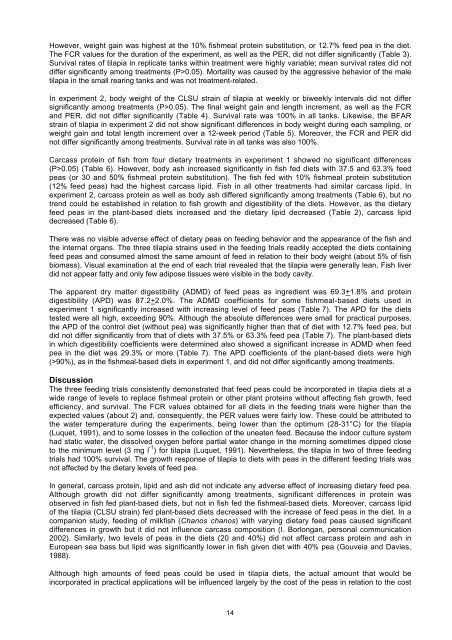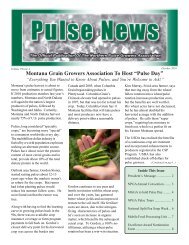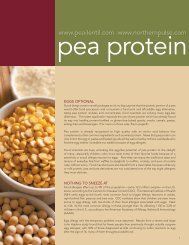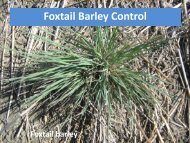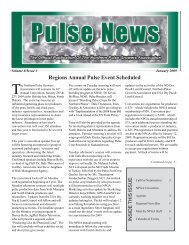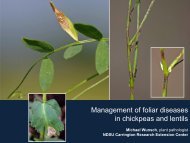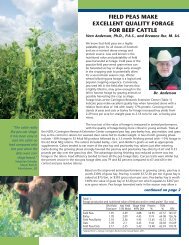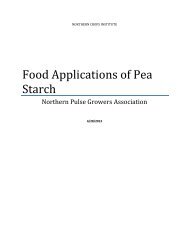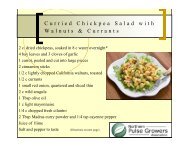Feed Peas in diets for shrimp tilapia and milkfish - Northern Pulse ...
Feed Peas in diets for shrimp tilapia and milkfish - Northern Pulse ...
Feed Peas in diets for shrimp tilapia and milkfish - Northern Pulse ...
Create successful ePaper yourself
Turn your PDF publications into a flip-book with our unique Google optimized e-Paper software.
However, weight ga<strong>in</strong> was highest at the 10% fishmeal prote<strong>in</strong> substitution, or 12.7% feed pea <strong>in</strong> the diet.The FCR values <strong>for</strong> the duration of the experiment, as well as the PER, did not differ significantly (Table 3).Survival rates of <strong>tilapia</strong> <strong>in</strong> replicate tanks with<strong>in</strong> treatment were highly variable; mean survival rates did notdiffer significantly among treatments (P>0.05). Mortality was caused by the aggressive behavior of the male<strong>tilapia</strong> <strong>in</strong> the small rear<strong>in</strong>g tanks <strong>and</strong> was not treatment-related.In experiment 2, body weight of the CLSU stra<strong>in</strong> of <strong>tilapia</strong> at weekly or biweekly <strong>in</strong>tervals did not differsignificantly among treatments (P>0.05). The f<strong>in</strong>al weight ga<strong>in</strong> <strong>and</strong> length <strong>in</strong>crement, as well as the FCR<strong>and</strong> PER, did not differ significantly (Table 4). Survival rate was 100% <strong>in</strong> all tanks. Likewise, the BFARstra<strong>in</strong> of <strong>tilapia</strong> <strong>in</strong> experiment 2 did not show significant differences <strong>in</strong> body weight dur<strong>in</strong>g each sampl<strong>in</strong>g, orweight ga<strong>in</strong> <strong>and</strong> total length <strong>in</strong>crement over a 12-week period (Table 5). Moreover, the FCR <strong>and</strong> PER didnot differ significantly among treatments. Survival rate <strong>in</strong> all tanks was also 100%.Carcass prote<strong>in</strong> of fish from four dietary treatments <strong>in</strong> experiment 1 showed no significant differences(P>0.05) (Table 6). However, body ash <strong>in</strong>creased significantly <strong>in</strong> fish fed <strong>diets</strong> with 37.5 <strong>and</strong> 63.3% feedpeas (or 30 <strong>and</strong> 50% fishmeal prote<strong>in</strong> substitution). The fish fed with 10% fishmeal prote<strong>in</strong> substitution(12% feed peas) had the highest carcass lipid. Fish <strong>in</strong> all other treatments had similar carcass lipid. Inexperiment 2, carcass prote<strong>in</strong> as well as body ash differed significantly among treatments (Table 6), but notrend could be established <strong>in</strong> relation to fish growth <strong>and</strong> digestibility of the <strong>diets</strong>. However, as the dietaryfeed peas <strong>in</strong> the plant-based <strong>diets</strong> <strong>in</strong>creased <strong>and</strong> the dietary lipid decreased (Table 2), carcass lipiddecreased (Table 6).There was no visible adverse effect of dietary peas on feed<strong>in</strong>g behavior <strong>and</strong> the appearance of the fish <strong>and</strong>the <strong>in</strong>ternal organs. The three <strong>tilapia</strong> stra<strong>in</strong>s used <strong>in</strong> the feed<strong>in</strong>g trials readily accepted the <strong>diets</strong> conta<strong>in</strong><strong>in</strong>gfeed peas <strong>and</strong> consumed almost the same amount of feed <strong>in</strong> relation to their body weight (about 5% of fishbiomass). Visual exam<strong>in</strong>ation at the end of each trial revealed that the <strong>tilapia</strong> were generally lean. Fish liverdid not appear fatty <strong>and</strong> only few adipose tissues were visible <strong>in</strong> the body cavity.The apparent dry matter digestibility (ADMD) of feed peas as <strong>in</strong>gredient was 69.3+1.8% <strong>and</strong> prote<strong>in</strong>digestibility (APD) was 87.2+2.0%. The ADMD coefficients <strong>for</strong> some fishmeal-based <strong>diets</strong> used <strong>in</strong>experiment 1 significantly <strong>in</strong>creased with <strong>in</strong>creas<strong>in</strong>g level of feed peas (Table 7). The APD <strong>for</strong> the <strong>diets</strong>tested were all high, exceed<strong>in</strong>g 90%. Although the absolute differences were small <strong>for</strong> practical purposes,the APD of the control diet (without pea) was significantly higher than that of diet with 12.7% feed pea, butdid not differ significantly from that of <strong>diets</strong> with 37.5% or 63.3% feed pea (Table 7). The plant-based <strong>diets</strong><strong>in</strong> which digestibility coefficients were determ<strong>in</strong>ed also showed a significant <strong>in</strong>crease <strong>in</strong> ADMD when feedpea <strong>in</strong> the diet was 29.3% or more (Table 7). The APD coefficients of the plant-based <strong>diets</strong> were high(>90%), as <strong>in</strong> the fishmeal-based <strong>diets</strong> <strong>in</strong> experiment 1, <strong>and</strong> did not differ significantly among treatments.DiscussionThe three feed<strong>in</strong>g trials consistently demonstrated that feed peas could be <strong>in</strong>corporated <strong>in</strong> <strong>tilapia</strong> <strong>diets</strong> at awide range of levels to replace fishmeal prote<strong>in</strong> or other plant prote<strong>in</strong>s without affect<strong>in</strong>g fish growth, feedefficiency, <strong>and</strong> survival. The FCR values obta<strong>in</strong>ed <strong>for</strong> all <strong>diets</strong> <strong>in</strong> the feed<strong>in</strong>g trials were higher than theexpected values (about 2) <strong>and</strong>, consequently, the PER values were fairly low. These could be attributed tothe water temperature dur<strong>in</strong>g the experiments, be<strong>in</strong>g lower than the optimum (28-31°C) <strong>for</strong> the <strong>tilapia</strong>(Luquet, 1991), <strong>and</strong> to some losses <strong>in</strong> the collection of the uneaten feed. Because the <strong>in</strong>door culture systemhad static water, the dissolved oxygen be<strong>for</strong>e partial water change <strong>in</strong> the morn<strong>in</strong>g sometimes dipped closeto the m<strong>in</strong>imum level (3 mg l -1 ) <strong>for</strong> <strong>tilapia</strong> (Luquet, 1991). Nevertheless, the <strong>tilapia</strong> <strong>in</strong> two of three feed<strong>in</strong>gtrials had 100% survival. The growth response of <strong>tilapia</strong> to <strong>diets</strong> with peas <strong>in</strong> the different feed<strong>in</strong>g trials wasnot affected by the dietary levels of feed pea.In general, carcass prote<strong>in</strong>, lipid <strong>and</strong> ash did not <strong>in</strong>dicate any adverse effect of <strong>in</strong>creas<strong>in</strong>g dietary feed pea.Although growth did not differ significantly among treatments, significant differences <strong>in</strong> prote<strong>in</strong> wasobserved <strong>in</strong> fish fed plant-based <strong>diets</strong>, but not <strong>in</strong> fish fed the fishmeal-based <strong>diets</strong>. Moreover, carcass lipidof the <strong>tilapia</strong> (CLSU stra<strong>in</strong>) fed plant-based <strong>diets</strong> decreased with the <strong>in</strong>crease of feed peas <strong>in</strong> the diet. In acompanion study, feed<strong>in</strong>g of <strong>milkfish</strong> (Chanos chanos) with vary<strong>in</strong>g dietary feed peas caused significantdifferences <strong>in</strong> growth but it did not <strong>in</strong>fluence carcass composition (I. Borlongan, personal communication2002). Similarly, two levels of peas <strong>in</strong> the <strong>diets</strong> (20 <strong>and</strong> 40%) did not affect carcass prote<strong>in</strong> <strong>and</strong> ash <strong>in</strong>European sea bass but lipid was significantly lower <strong>in</strong> fish given diet with 40% pea (Gouveia <strong>and</strong> Davies,1988).Although high amounts of feed peas could be used <strong>in</strong> <strong>tilapia</strong> <strong>diets</strong>, the actual amount that would be<strong>in</strong>corporated <strong>in</strong> practical applications will be <strong>in</strong>fluenced largely by the cost of the peas <strong>in</strong> relation to the cost14


